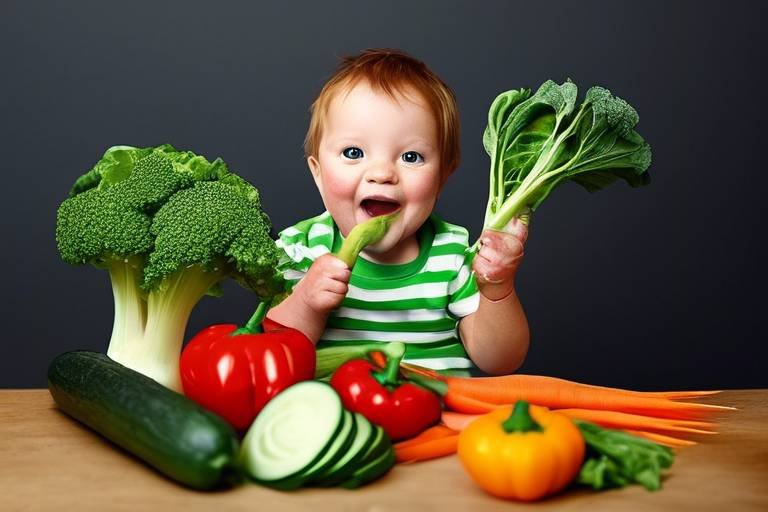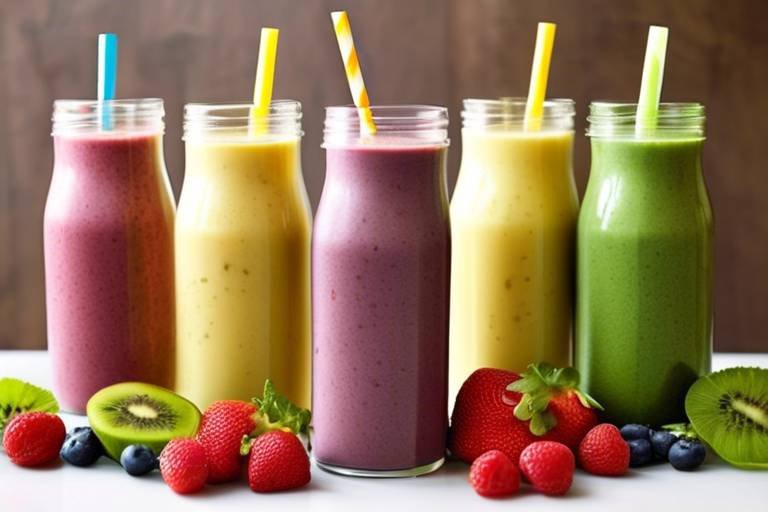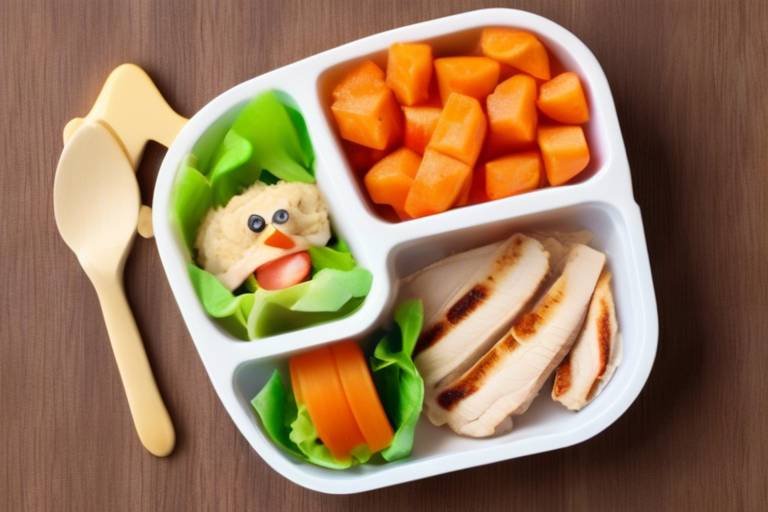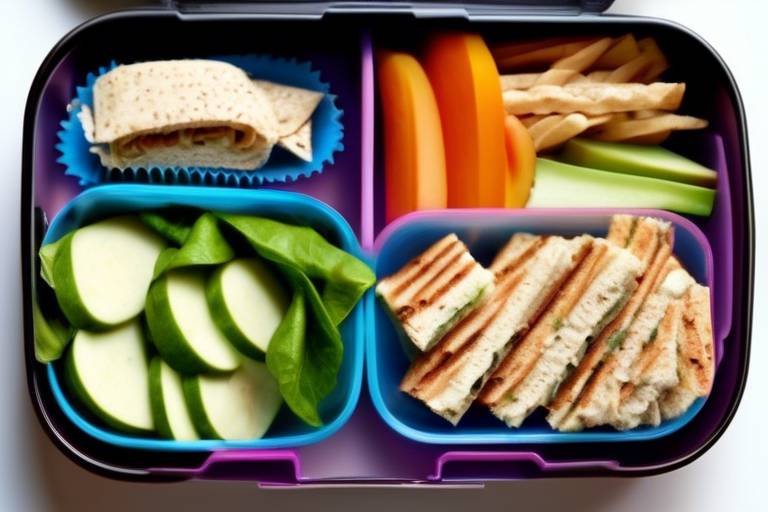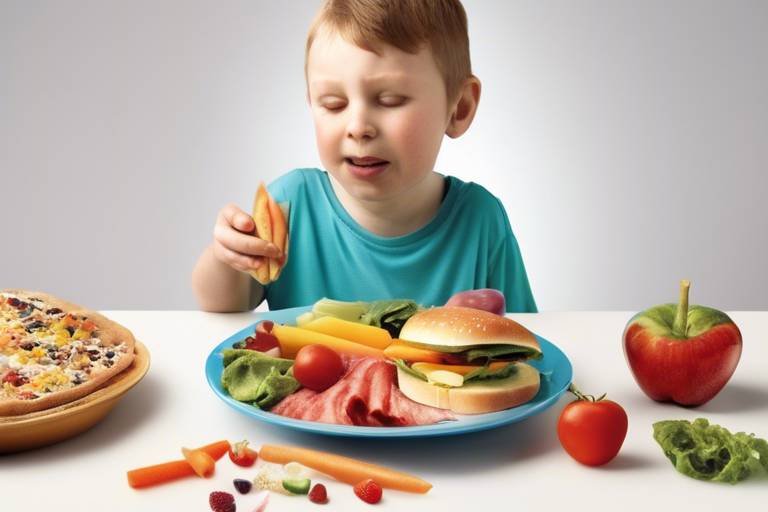How to Make Vegetables Kid-Friendly
Getting kids to eat their vegetables can often feel like an uphill battle for many parents. But what if I told you that with a little creativity and some fun strategies, you could turn mealtime into an enjoyable adventure? The key lies in making vegetables exciting and inviting. This article is packed with innovative ideas that will help you encourage your children to embrace the green goodness on their plates. Let’s dive into some fantastic ways to make vegetables not just a part of the meal, but a highlight of it!
First things first, let’s talk about presentation. Imagine a plate filled with vibrant colors and fun shapes; it’s like a little artwork waiting to be devoured! Transforming the way vegetables are presented can make them more appealing to kids. Instead of a boring pile of steamed broccoli, how about creating a rainbow platter? You can use cookie cutters to shape cucumbers into stars or slice bell peppers into fun, wavy strips. This not only makes the vegetables look more appetizing but also sparks curiosity. Kids are naturally drawn to fun shapes and colors, so why not leverage that to your advantage?
Another effective strategy is to incorporate vegetables into your children's favorite dishes. Think of it as a stealthy operation to enhance nutrition without overwhelming their taste buds. For example, adding finely chopped spinach into a cheesy pasta dish or blending carrots into a savory meat sauce can do wonders. These sneaky additions can provide essential nutrients while keeping the meal familiar and enjoyable. It’s all about making vegetables feel like a natural part of what they already love!
One of the best ways to blend vegetables with fruits is through smoothies. Kids often gravitate towards the sweetness of fruit, which makes it easier to sneak in some veggies. Just picture this: a delicious smoothie that tastes like a treat but is packed with nutrients! You can whip up a smoothie with a base of bananas and spinach – the banana masks the taste of the spinach while still providing a creamy texture. It’s a win-win situation!
Selecting the right fruits to pair with specific vegetables can enhance the flavor and make the smoothie even more enticing. For instance, strawberries and kale can create a vibrant, sweet blend that kids will love. Here’s a quick look at some great combinations:
| Fruit | Vegetable | Taste Profile |
|---|---|---|
| Banana | Spinach | Sweet and Creamy |
| Strawberry | Kale | Sweet and Earthy |
| Mango | Carrot | Tropical and Sweet |
Involving kids in the blending process can also make them more excited about trying the smoothie. Let them choose their ingredients or even press the buttons on the blender. This sense of ownership can transform their perception of vegetables from something they have to eat into something they want to create. Plus, it’s a fantastic way to bond and share a delicious, healthy treat together!
Pairing vegetables with tasty dips can make them more inviting. Kids are much more likely to munch on carrots, cucumbers, and bell peppers when they have a fun dip to enjoy. Think about hummus, ranch dressing, or even a homemade yogurt dip. You can make it a fun activity by allowing kids to help prepare the dips, introducing them to new flavors while keeping the experience enjoyable.
Engaging children in gardening can spark their interest in vegetables. When kids grow their own food, they are often more willing to try what they’ve cultivated. It’s an educational experience that teaches them about where food comes from and the effort it takes to grow it. Plus, there’s something incredibly rewarding about eating a vegetable that you’ve nurtured from seed to plate.
When starting a garden with kids, it’s essential to select vegetables that are simple to grow. Varieties like cherry tomatoes, radishes, and lettuce are great options. They grow quickly, which keeps kids motivated and excited about the process. Watching their plants flourish can instill a sense of pride and accomplishment, making them more inclined to eat what they’ve helped to grow.
Teaching kids about how vegetables grow can increase their appreciation for them. Discussing the life cycle of plants, from seed to harvest, can foster curiosity and excitement around eating vegetables. You can even create a fun project where they document the growth of their plants, turning a simple gardening task into a thrilling science experiment!
- What are some vegetables that kids usually like? Carrots, sweet bell peppers, and cherry tomatoes are often favorites!
- How can I make vegetables more appealing? Try creative presentations, dips, and incorporating them into favorite dishes.
- Is it okay to sneak vegetables into meals? Yes! Sneaking veggies into familiar dishes can help kids accept them more readily.

Creative Presentation
Transforming the way vegetables are presented can make a world of difference when it comes to getting kids excited about eating them. Imagine a colorful rainbow on their plate, where vibrant reds, greens, and yellows dance together, creating a feast for the eyes. Fun shapes and playful arrangements can entice children to try new vegetables, and the more visually appealing the dish, the more likely they are to dig in. Think about it: would you rather eat a plain carrot stick or a carrot cut into fun shapes like stars or hearts? The latter not only looks better but also makes the experience of eating more enjoyable.
One great way to achieve this is by using cookie cutters to create fun shapes out of vegetables. You can turn cucumbers into stars, bell peppers into flowers, and even make silly faces with a variety of veggies. This approach not only makes the food look fun but also encourages kids to engage with their food. You might even consider arranging vegetables in the shape of a favorite character, like a dinosaur or a superhero, to make mealtime an adventure.
Another strategy is to create a vegetable rainbow on the plate. This involves using a variety of colorful vegetables, such as red tomatoes, orange carrots, yellow corn, green cucumbers, and purple cabbage. By arranging them in a way that resembles a rainbow, you're not just providing a nutritious meal; you're also creating a visual masterpiece that kids will be excited to eat. You can even make it a fun game by asking them to identify all the colors in their rainbow and the veggies that correspond to each color.
Moreover, don’t forget about the power of dips! Pairing vegetables with tasty dips can make them more inviting. Kids are more likely to munch on carrots, cucumbers, and bell peppers if they have a delicious dip to enjoy alongside them. Consider offering a variety of dips, such as hummus, yogurt-based ranch, or guacamole, and let the kids choose their favorites. This not only adds flavor but also makes the experience interactive and fun.
Incorporating these creative presentation techniques can transform mealtime from a chore into an exciting event. By making vegetables visually appealing and engaging, you’re not just encouraging your children to eat healthier; you’re also instilling a sense of curiosity and adventure in their eating habits. Remember, the more fun you make it, the more likely they are to embrace the world of vegetables!
- Why is it important to make vegetables appealing to kids? Making vegetables appealing can encourage children to try them, leading to healthier eating habits and better nutrition.
- What are some fun ways to present vegetables? Use cookie cutters for fun shapes, create a vegetable rainbow, or serve veggies with dips to make them more enticing.
- How can I get my child involved in the process? Involve them in choosing vegetables, preparing the meal, and presenting the food creatively to foster a sense of ownership.

Incorporating into Favorite Dishes
When it comes to getting kids to eat their vegetables, one of the most effective strategies is to incorporate them into their favorite dishes. Think about it: if children are already excited about a meal, they’re more likely to accept the added nutrition without even realizing it! This approach not only enhances the meal but also makes it a fun culinary adventure. For instance, you can sneak finely chopped spinach into a cheesy lasagna or mix shredded carrots into a savory meatloaf. The key is to blend the flavors in a way that makes the veggies disappear into the dish, allowing the kids to focus on the deliciousness rather than the greens.
Another great way to incorporate vegetables is through pasta dishes. Whether it’s a classic spaghetti or a creamy Alfredo, adding vegetables like zucchini, bell peppers, or broccoli can elevate the dish both in flavor and nutrition. You can sauté these veggies with some olive oil and garlic before mixing them into the sauce. The vibrant colors and enticing aroma will not only make the meal more appealing but also encourage children to give it a try. Plus, a dash of parmesan cheese can make any veggie taste better, right?
Don't forget about pizza night! Kids love pizza, and it's a fantastic opportunity to load up on veggies. Try topping your homemade or store-bought pizza with a variety of colorful vegetables such as spinach, mushrooms, and bell peppers. You can even create fun shapes with the toppings to make it visually appealing. Another fun idea is to let the kids assemble their own pizzas, allowing them to choose which vegetables to add. This not only gives them a sense of control but also makes them more likely to eat what they’ve helped create.
For those who enjoy breakfast, incorporating vegetables into omelets or scrambled eggs can be a game-changer. Chopped tomatoes, onions, and spinach can add flavor and nutrition to a morning favorite. You can even make it a family tradition to create a “veggie omelet bar” where everyone can customize their breakfast with their favorite ingredients. This interactive approach not only makes breakfast fun but also teaches kids about healthy eating habits.
Lastly, consider using soups and stews as a canvas for vegetables. A hearty vegetable soup can be a great way to introduce new flavors, and the warmth of the broth can make it comforting and inviting. You can blend the soup for a creamy texture or leave it chunky for added interest. Kids often enjoy dipping bread into soup, which can make the whole experience more enjoyable. Just remember, the more colorful and vibrant the dish, the more likely it is to catch a child's eye!
In summary, by incorporating vegetables into dishes that kids already love, you create an environment where they can explore new tastes without feeling pressured. It’s all about making vegetables a natural part of their favorite meals, and with a little creativity, mealtime can become a delightful experience for the whole family!
- How can I hide vegetables in meals without my kids noticing?
Finely chop or puree vegetables and mix them into sauces, soups, or baked goods to mask their presence. - What are some easy vegetables to incorporate into kids' meals?
Vegetables like carrots, spinach, and bell peppers are versatile and can be added to many dishes without altering the taste significantly. - Can I involve my kids in the cooking process?
Absolutely! Letting kids help in the kitchen can make them more excited about trying new foods, including vegetables.

Vegetable Smoothies
Smoothies are not just a trendy drink; they can be a game changer when it comes to sneaking in those all-important vegetables into your child’s diet. Imagine a vibrant, delicious drink that not only tastes fantastic but is also packed with nutrients—sounds like a win-win, right? The secret lies in the combination of fruits and vegetables that can mask the taste of greens while still delivering essential vitamins and minerals. Kids often have a sweet tooth, and by blending vegetables with their favorite fruits, you can create a concoction that they’ll be excited to drink.
To make the perfect vegetable smoothie, start by choosing the right ingredients. Some fruits pair beautifully with vegetables, enhancing flavor while keeping the smoothie sweet and palatable. For example, bananas are a fantastic base because they add creaminess and sweetness, making them an ideal partner for spinach. This combo not only tastes great but also packs a nutritious punch. Other great combinations include:
- Carrots with oranges or mangoes
- Kale with pineapple or apple
- Beets with berries
But why stop there? Involve your kids in the blending process! Let them choose their ingredients, and watch their excitement grow as they see their creation come to life. It’s not just about drinking a smoothie; it’s about the experience of making it together. Ask them questions like, “What color do you want your smoothie to be?” or “Should we add a splash of yogurt for creaminess?” This interaction fosters a sense of ownership and makes them more likely to enjoy what they’ve crafted.
Another fun idea is to create a “smoothie bar” at home. Set up a variety of fruits and vegetables, along with different toppings like granola or chia seeds. Let your kids mix and match until they find their perfect blend. This not only makes for a fun family activity but also encourages them to experiment with different flavors and textures.
In summary, vegetable smoothies are a fantastic way to introduce your kids to the world of vegetables without them even realizing it. With a little creativity and some fun, you can turn what might be a daunting task into an enjoyable experience that benefits the whole family. So, grab your blender, and let the smoothie-making adventures begin!

Choosing the Right Ingredients
When it comes to making vegetables appealing for kids, the right ingredients can make all the difference. Imagine crafting a smoothie that not only hides the veggies but also tastes like a delicious treat. The key is to pair vegetables with fruits that complement their flavors. For example, spinach has a mild taste that blends seamlessly with sweeter fruits like bananas and mangoes. The sweetness of these fruits can mask the earthy flavor of spinach, making it more palatable for young taste buds.
Another fantastic combination is carrots and oranges. The citrusy zing of oranges can bring out the natural sweetness of carrots, creating a vibrant and tasty smoothie that kids will love. This not only makes the drink appealing but also packs a nutritional punch. When choosing ingredients, it’s essential to consider both the taste and the nutritional value. You want to create a smoothie that is not just delicious but also loaded with vitamins and minerals.
Additionally, incorporating ingredients that are visually appealing can also enhance the experience. Brightly colored fruits like strawberries, blueberries, and kiwis can make the smoothie look enticing. When kids see a rainbow of colors in their drink, they are more likely to be curious and give it a try. A simple rule of thumb is to aim for a mix of colors—this not only looks great but also ensures a variety of nutrients.
Lastly, don't forget about texture! Adding a bit of yogurt or oats can create a creamy consistency that kids may find more enjoyable. The fun part is letting the kids experiment with their own combinations. You can set up a mini smoothie bar with various fruits and vegetables, allowing them to choose their favorites. This not only makes them more likely to drink the smoothie but also gives them a sense of ownership over their food choices.
In summary, choosing the right ingredients for kid-friendly smoothies involves a careful balance of taste, nutrition, and visual appeal. By combining sweet fruits with mild vegetables and allowing kids to participate in the selection process, you can create delicious drinks that they will be excited to enjoy!
Q: What vegetables are best for smoothies?
A: Mild-flavored vegetables like spinach, kale, and carrots are great choices since they blend well with fruits without overpowering the flavor.
Q: Can I use frozen fruits and vegetables?
A: Absolutely! Frozen fruits and vegetables are convenient and can add a refreshing chill to your smoothies.
Q: How can I get my child involved in making smoothies?
A: Let your child choose their favorite fruits and vegetables, and allow them to help with the blending process. This can make them more excited about trying their creations!

Fun Blending Techniques
This article provides creative strategies and tips for parents to encourage children to enjoy vegetables, making mealtime enjoyable and nutritious for the whole family.
Transforming the way vegetables are presented can make them more appealing to kids. Fun shapes and colorful arrangements can entice children to try new vegetables.
Adding vegetables to familiar meals can help kids accept them more readily. By sneaking them into favorite recipes, parents can enhance nutrition without overwhelming their children.
Smoothies are a great way to blend vegetables with fruits, masking the taste while providing essential nutrients. Kids often enjoy the sweetness of fruit, making it easier to include veggies.
Selecting fruits that pair well with specific vegetables can enhance flavor. For instance, bananas and spinach create a deliciously nutritious smoothie that kids love.
Involving kids in the blending process can make them more excited about trying the smoothie. Imagine the joy on their faces as they watch the vibrant colors swirl together! Here are some engaging techniques to make blending a fun experience:
- Let Them Choose: Allow your children to pick their favorite fruits and veggies to include. This not only gives them a sense of ownership but also encourages them to experiment with different flavors.
- Add Some Music: Play some upbeat music while blending to create a fun atmosphere. You could even have a mini dance party in the kitchen while waiting for the smoothie to blend!
- Colorful Cups: Serve the smoothies in colorful cups or fun straws. The visual appeal can be a game changer, making them more enticing to drink.
Additionally, you can create a “smoothie challenge” where everyone in the family creates their own unique blend. This not only fosters creativity but also promotes friendly competition. Kids will be more inclined to try each other's concoctions, and who knows, they might discover a new favorite!
Engaging children in gardening can spark their interest in vegetables. When kids grow their own food, they are often more willing to try what they’ve cultivated.
Selecting vegetables that are simple to grow can ensure success and keep kids motivated. Varieties like cherry tomatoes and radishes can be rewarding and fun to harvest.
Teaching kids about how vegetables grow can increase their appreciation for them. Discussing the life cycle of plants can foster curiosity and excitement around eating vegetables.
Q: How can I encourage my child to try new vegetables?
A: Start by incorporating vegetables into their favorite dishes or presenting them in fun shapes. Engaging them in the cooking process can also pique their interest.
Q: What are some easy vegetables to grow with kids?
A: Easy-to-grow vegetables include cherry tomatoes, radishes, and lettuce. These are not only simple to cultivate but also quick to harvest, keeping kids motivated.
Q: How can I make smoothies more appealing to my child?
A: Involve them in choosing ingredients, use colorful cups, and create a fun atmosphere while blending. Adding music or making it a family challenge can also enhance the experience.

Vegetable Dips
One of the most effective ways to make vegetables appealing to children is by pairing them with delicious dips. Imagine a vibrant plate of crunchy carrots, crisp cucumbers, and colorful bell peppers, all waiting to be dunked into a creamy, flavorful dip. This simple addition can transform the mundane act of eating vegetables into an exciting culinary adventure. Kids are naturally drawn to fun and engaging experiences, and dips can provide that extra layer of enjoyment.
So, what kinds of dips can elevate the vegetable-eating experience? Here are a few ideas that not only taste great but are also easy to prepare:
- Hummus: This creamy chickpea dip is rich in protein and can be flavored with various ingredients, such as garlic, roasted red peppers, or even spinach for an extra nutrient boost.
- Yogurt-based dips: Mixing plain yogurt with herbs and spices can create a refreshing dip that pairs perfectly with veggies. Think of tzatziki, which combines yogurt with cucumber and garlic for a cool, tangy flavor.
- Guacamole: Creamy avocado blended with lime juice, salt, and diced tomatoes makes for a rich dip that kids love. Plus, avocados are packed with healthy fats!
- Peanut butter or almond butter: For a sweet twist, nut butters can be a hit with apple slices, celery sticks, or even bell pepper strips, adding a fun flavor combination.
Encouraging kids to dip their vegetables can also be a fantastic way to engage them in the kitchen. Allowing them to help prepare the dips not only teaches them valuable cooking skills but also fosters a sense of ownership over their meals. When children are involved in the process, they are more likely to be excited about trying new foods. You could set up a "dip station" where they can mix and match their favorite ingredients to create their own concoctions.
Additionally, presentation plays a crucial role in making vegetable dips appealing. Consider using colorful bowls, arranging the veggies in fun shapes, or even creating a rainbow platter. A visually appealing setup can ignite curiosity and encourage children to explore the flavors.
In summary, pairing vegetables with tasty dips is a surefire way to entice kids to eat their greens. By offering a variety of dips and involving children in the preparation, parents can turn mealtime into a fun and interactive experience. So, the next time you're serving vegetables, remember that a little dip can go a long way in making them kid-friendly!
Q: How can I make my vegetable dips healthier?
A: You can use Greek yogurt as a base for creamy dips, incorporate pureed vegetables, or add herbs and spices for flavor without extra calories.
Q: What vegetables are best for dipping?
A: Crunchy vegetables like carrots, cucumbers, bell peppers, and celery are excellent choices for dipping, as they hold up well and provide satisfying textures.
Q: Can I freeze vegetable dips?
A: Some dips, like hummus, can be frozen, but creamy dips based on yogurt may not retain their texture after freezing. It's best to prepare them fresh.

Gardening Together
Engaging children in gardening can be a transformative experience that not only sparks their interest in vegetables but also serves as a fantastic bonding activity for the whole family. Imagine the joy on their faces as they plant seeds, water the soil, and watch their efforts blossom into edible delights! When kids are involved in the entire process—from planting to harvesting—they develop a sense of ownership and pride in what they grow. This connection often translates into a greater willingness to try the vegetables they’ve nurtured themselves.
One of the first steps in making gardening appealing to kids is to choose easy-to-grow varieties. Selecting vegetables that sprout quickly and require minimal maintenance can ensure success and keep children motivated. For instance, cherry tomatoes and radishes are not only fun to grow but also provide instant gratification as they mature in a matter of weeks. The vibrant colors and familiar shapes of these vegetables can capture a child's imagination, making them more likely to sample what they’ve grown.
Additionally, understanding the growth process can significantly enhance a child's appreciation for vegetables. As you plant seeds together, take the time to discuss the life cycle of plants. Explain how seeds germinate, grow roots, and eventually produce delicious vegetables. This educational aspect of gardening can foster curiosity and excitement around eating vegetables. You might even consider creating a simple chart to track the growth of your plants, which can serve as a visual representation of their hard work and dedication.
Gardening can also be a wonderful opportunity to teach kids about nutrition and the importance of eating a variety of foods. As they witness the transformation from seed to salad, you can share fun facts about the nutritional benefits of the vegetables they are growing. For example, did you know that carrots are not just crunchy and sweet, but they also help improve vision? By connecting the dots between gardening and healthy eating, you’re instilling lifelong habits that can benefit their health.
To make the gardening experience even more enjoyable, consider organizing small family gardening days where everyone can contribute. You could set up a schedule for watering, weeding, and harvesting, allowing each family member to take on specific responsibilities. This collaborative effort will not only make the work lighter but also create cherished memories. Plus, you can celebrate your harvest with a family meal featuring the vegetables you’ve grown together, reinforcing the idea that gardening leads to delicious, healthy food.
- What are some easy vegetables for kids to grow? Cherry tomatoes, radishes, and peas are excellent choices due to their quick growth and vibrant colors.
- How can I get my child interested in gardening? Start by involving them in the process, making it fun and educational, and choosing vegetables they will enjoy eating.
- What tools do we need for gardening with kids? Basic gardening tools such as small shovels, watering cans, and gloves are sufficient to get started.

Choosing Easy-to-Grow Varieties
This article provides creative strategies and tips for parents to encourage children to enjoy vegetables, making mealtime enjoyable and nutritious for the whole family.
Transforming the way vegetables are presented can make them more appealing to kids. Fun shapes and colorful arrangements can entice children to try new vegetables.
Adding vegetables to familiar meals can help kids accept them more readily. By sneaking them into favorite recipes, parents can enhance nutrition without overwhelming their children.
Smoothies are a great way to blend vegetables with fruits, masking the taste while providing essential nutrients. Kids often enjoy the sweetness of fruit, making it easier to include veggies.
Selecting fruits that pair well with specific vegetables can enhance flavor. For instance, bananas and spinach create a deliciously nutritious smoothie that kids love.
Involving kids in the blending process can make them more excited about trying the smoothie. Allowing them to choose ingredients can also foster a sense of ownership.
Pairing vegetables with tasty dips can make them more inviting. Kids are more likely to eat carrots, cucumbers, and bell peppers when they have a fun dip to enjoy.
Engaging children in gardening can spark their interest in vegetables. When kids grow their own food, they are often more willing to try what they’ve cultivated.
When it comes to gardening with kids, selecting easy-to-grow varieties can make all the difference. Imagine the excitement on your child's face when they see their first vegetable sprouting from the soil! Some vegetables are particularly forgiving for beginners and can thrive even with minimal care. For instance, cherry tomatoes are not only delicious but also grow quickly, providing a rewarding harvest that kids can enjoy right off the vine. Similarly, radishes are perfect for impatient little gardeners because they mature in just a few weeks.
To further engage your children, consider creating a small garden chart where they can track the growth of their plants. This can also serve as a fun educational opportunity to teach them about the different stages of plant development. Here’s a quick breakdown of some easy-to-grow vegetables:
| Vegetable | Growth Time | Harvesting Tips |
|---|---|---|
| Cherry Tomatoes | 60-80 days | Pick when fully colored and slightly soft. |
| Radishes | 25-30 days | Harvest when they are about 1 inch in diameter. |
| Carrots | 70-80 days | Pull when the tops are about 1 inch wide. |
| Lettuce | 30-60 days | Pick leaves when they are young for the best flavor. |
By choosing these varieties, you not only ensure that the gardening experience is enjoyable but also instill a sense of accomplishment in your kids. They’ll be more likely to eat what they’ve grown, and who knows? They might even develop a lifelong love for vegetables!
Teaching kids about how vegetables grow can increase their appreciation for them. Discussing the life cycle of plants can foster curiosity and excitement around eating vegetables.
- What are some other easy vegetables for kids to grow? Consider peas, zucchini, and herbs like basil or mint.
- How can I make vegetables more appealing at mealtime? Use fun shapes, colorful dips, and involve kids in cooking.
- What are some good vegetable smoothie recipes? Try mixing spinach with bananas and strawberries for a tasty treat.

Understanding the Growth Process
Understanding how vegetables grow is not just about the science; it’s about creating a connection between kids and their food. When children learn about the journey from seed to plate, they often develop a deeper appreciation for the vegetables they eat. Imagine planting a tiny seed and watching it transform into a vibrant, crunchy carrot or a juicy tomato. This magical process can spark curiosity and excitement, making kids more willing to try the fruits of their labor.
To help children grasp the growth process, parents can introduce simple concepts about plant life cycles. Here’s a brief overview of the stages:
| Stage | Description |
|---|---|
| Seed | The starting point where the plant begins its journey. |
| Germination | The process where the seed absorbs water and begins to sprout. |
| Seedling | A young plant that develops leaves and roots. |
| Mature Plant | The fully grown plant that is ready for harvest. |
Engaging kids in discussions about these stages can be a fun and educational experience. You might ask them questions like, “What do you think happens to a seed when it’s planted in the soil?” or “How long do you think it takes for a seed to grow into a plant?” Such questions encourage critical thinking and make the learning process interactive.
Additionally, hands-on activities can reinforce this understanding. For instance, planting seeds in small pots and tracking their growth can be a thrilling project for kids. They can create a growth chart, noting the changes they observe each week. This not only teaches them patience but also allows them to witness the miracle of growth firsthand.
Moreover, sharing interesting facts about vegetables can pique their interest even further. For example, did you know that some plants can grow in just a few days while others take months? Or that certain vegetables, like radishes, are among the fastest to mature? These fun tidbits can make the learning process more enjoyable and memorable.
Ultimately, by fostering an understanding of the growth process, parents can help children see vegetables not just as food, but as a part of a larger story. This connection can lead to healthier eating habits and a greater willingness to explore a variety of vegetables, making mealtime a delightful adventure for the entire family.
- How can I encourage my child to try new vegetables? Present vegetables in fun shapes, involve them in cooking, and pair them with tasty dips.
- What are some easy vegetables to grow with kids? Cherry tomatoes, radishes, and lettuce are great options for beginner gardeners.
- How can I make vegetables more appealing to my child? Use creative presentations, incorporate them into favorite dishes, and engage them in the gardening process.
Frequently Asked Questions
- How can I make vegetables more appealing to my kids?
Transforming the presentation of vegetables can work wonders! Try using fun shapes with cookie cutters or arranging them in colorful patterns on the plate. You can even create veggie art! The more visually exciting the veggies are, the more likely your kids will want to try them.
- What are some easy ways to incorporate vegetables into my child's favorite dishes?
One effective method is to sneak vegetables into meals they already love. For instance, you can add finely chopped spinach to pasta sauce or mix grated carrots into meatballs. It’s like a secret mission for nutrition—your kids won’t even know they’re eating their veggies!
- Are smoothies a good option for getting kids to eat vegetables?
Absolutely! Smoothies are a fantastic way to blend fruits and vegetables together. Kids usually enjoy the sweetness of fruits, which can help mask the taste of veggies. Just blend some spinach or kale with bananas and berries, and you’ve got a delicious, nutrient-packed drink!
- What types of vegetables should I grow with my kids?
Start with easy-to-grow varieties like cherry tomatoes, radishes, or even herbs. These plants grow quickly and are rewarding to harvest, which can keep your kids engaged and excited about eating what they’ve grown. Gardening together can turn veggies into a fun adventure!
- How can I get my kids interested in gardening?
Involve them in the entire process—from planting seeds to watering and harvesting. Discuss the life cycle of plants and how vegetables grow. When kids see the effort that goes into growing their food, they often develop a greater appreciation for it and are more willing to try what they’ve cultivated.
- What are some fun dip ideas to encourage vegetable eating?
Kids love dips! Try hummus, yogurt-based ranch, or even guacamole. Pairing crunchy veggies like carrots and cucumbers with a tasty dip can make them much more inviting. It’s like turning healthy eating into a fun snack time!

